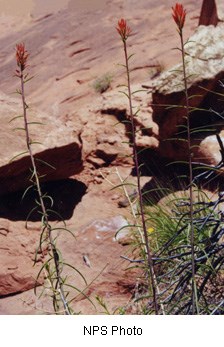
Castilleja linariifolia Family: Scrophulariaceae - Figwort Family Perennial herbs; some parasitic or semi-parasitic; 7.5” to 2.6' (1.9 to 8 dm) tall Leaves: alternate; simple; divided; 0.4” to 4” (1 to 10 cm) long; linear; can have hairs. Flowers: 4 or 5 united green tubular petals are irregular and 2-lipped (the upper lip beaklike with 2 lobes and the lower lip shorter with 3 lobes); 4 (at least partially united) tubular variously colored sepals; 4 stamens; flowerlike bracts are reddish and tubular; bilaterally symmetrical; usually bisexual; flowers are 1” to 2.08” (2.5 to 5.2 cm) long Pollinators: other Castilleja species are pollinated by insects and hummingbirds; red paintbrush is generally hummingbird pollinated and yellow, green, or purple paintbrush is generally bee pollinated Fruits: 2 chambered capsule (dry fruit) Blooms in Arches National Park: May, June, July, August, September, October Habitat in Arches National Park: grassland, desert shrub and pinyon-juniper communities Location seen: park road mile 4, Courthouse wash, park road near Petrified Dunes - mile 6.6, outside Arches National Park on Hwy. 128 mile 2.5 Other: The genus name, “Castilleja”, honors Domingo Castillejo, an 18th century Spanish botanist. The species name, “linariifolia”, means “with leaves like Linaria” referring to the narrow leaves which resemble those of “Linaria (Toadflax)”, another member of the Figwort Family. The family is important because of many ornamentals and cardiac glycosides that can be derived from foxglove. |
Last updated: April 29, 2025
